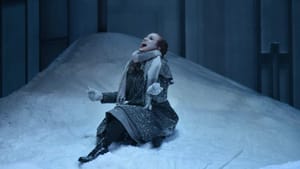Stay in the Loop
BSR publishes on a weekly schedule, with an email newsletter every Wednesday and Thursday morning. There’s no paywall, and subscribing is always free.
Starting point of no return
O18 Festival: Opera Philadelphia presents ‘Lucia di Lammermoor'

If Opera Philadelphia’s O18 Festival has an unofficial theme, it could be described as “women in peril.” (See my reviews of Sky on Swings and Ne Quittez Pas.) Few heroines experience as much turmoil as the title character of Donizetti’s Lucia di Lammermoor, which returns to the Academy of Music after an absence of two decades.
The daughter of a once-noble Scottish family, Lucia Ashton finds herself traded like cotton, forced into an arranged marriage to restore her family’s good name. Her pragmatic brother Enrico forbids her to see Edgardo, her true love and his sworn enemy. Although Lucia and Edgardo promise themselves to each other, the die is cast.
Stagnant story
A staple of the bel canto repertory, Lucia works best when its protagonist progresses from a hopeful girl to a broken woman, driven mad by the callous indifference shown her by the men in her life. The opera’s iconic mad scene, sung after Lucia murders her bridegroom on their wedding night, should represent a permanent break in her formerly controlled personality — a woman past the point of no return.
Here, director Laurent Pelly offers a Lucia who exudes anxious, foreboding lunacy from her first entrance onward. As portrayed by the American soprano Brenda Rae, she appears keening and moaning, her fists tightly clenched at her sides. Her large, expressive eyes all but eject from their sockets. She seems less a virginal bride-to-be than an escapee from Bedlam.
This perceived insanity causes the story to stagnate. With nowhere to go, the opera hurtles toward a foregone conclusion that’s neither surprising nor unsettling. And it causes Rae to offer a frenetic but ultimately flat characterization — she sings many notes, but she only acts one.
Varying voices
Rae’s high-lying soprano impresses with its effortless vocal production and stratospheric upper extension. The voice grows hollow in the middle and lower ranges; more problematically, it stays mostly colorless at all points. Perhaps to compensate for the lack of distinction in tone, she overenunciates the Italian text; if she rolls her Rs any harder, they’re liable to split in half.
By contrast, the American tenor Michael Spyres triumphs vocally and dramatically as Edgardo. He offers a proud and vengeful suitor whose regular shifts in mood — lovestruck, jealous, scornful, and ultimately heartbroken — all seem justified. For sheer tonal beauty and vocal heft, he reminds this listener of Franco Corelli and Carlo Bergonzi, two of the role’s greatest interpreters. It’s enough to forgive a slightly wayward pitch and some bleated notes in the opera’s final scene.

Baritone Troy Cook offers a well-sung Enrico, although his stiff acting leaves much to be desired. Christian Van Horn’s beautiful lyric bass is wasted on the minor role of Raimondo, the Ashton family priest. Andrew Owens makes an appropriately preening Arturo, with a pliant tenor to boot.
The promising mezzo-soprano Hannah Ludwig makes an impressive company debut as Alisa, Lucia’s devoted nurse. Her performance builds upon a series of fine portrayals during her student days at the Academy of Vocal Arts; if she continues to bring such distinction to comprimaria assignments, leading roles at major houses cannot be far behind.
Not too snappy
Pelly’s mise-en-scéne, with sets by Chantal Thomas and lighting by Duane Schuler, aims for menacing shadows and fog but only manages drabness. A series of set pieces meant to evoke the Ashton manor resemble scaffolding, for no apparent reason. Pelly’s costumes ground the production in the Victorian era, but he does little to reinforce a sense of that period’s repressive politics — a shame, given the opera’s underlying questions of gender expectations and filial loyalty.
Opera Philadelphia music director Corrado Rovaris conducts with a surprisingly slack hand — an odd predicament, given his usual preference for snappy tempos. The chorus, prepared by Elizabeth Braden, sounds not up to their generally high standards. Friedrich Heinrich Kern provides eerie accompaniment for Lucia’s mad scene on the glass harmonica, always a highlight of the piece.
The various positive strands of this Lucia fail to coalesce into a satisfying whole. In Pelly’s hands, a complex character remains both obvious and opaque.
What, When, Where
Lucia di Lammermoor. By Gaetano Donizetti and Salvatore Cammarano, Laurent Pelly directed. Opera Philadelphia. Through September 30, 2018, at the Academy of Music, 250 S. Broad Street, Philadelphia. (215) 732-8400 or operaphila.org.
Sign up for our newsletter
All of the week's new articles, all in one place. Sign up for the free weekly BSR newsletters, and don't miss a conversation.

 Cameron Kelsall
Cameron Kelsall